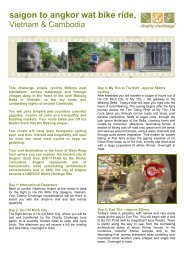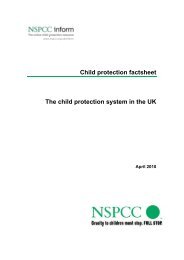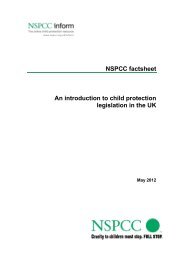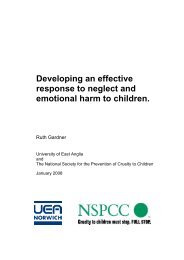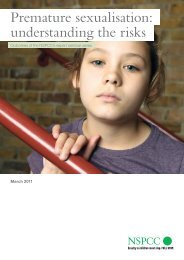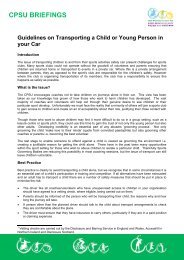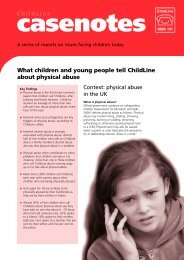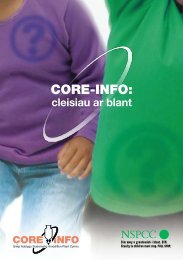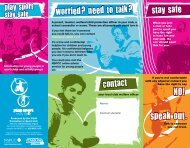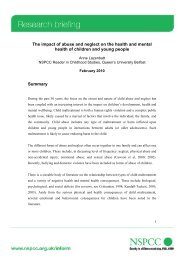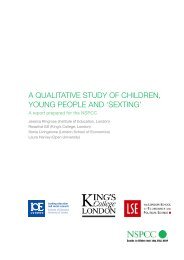Neglect and serious case reviews (PDF, 735KB) - nspcc
Neglect and serious case reviews (PDF, 735KB) - nspcc
Neglect and serious case reviews (PDF, 735KB) - nspcc
Create successful ePaper yourself
Turn your PDF publications into a flip-book with our unique Google optimized e-Paper software.
<strong>Neglect</strong> <strong>and</strong> Serious Case Reviews<br />
themeS aNd learNiNg poiNtS<br />
children not seen as individuals within a large family<br />
minimised its impact <strong>and</strong> had an over optimistic view of their ability to<br />
care safely. The situation was exacerbated by the fragmented nature<br />
of health <strong>and</strong> social care involvement in terms of key workers <strong>and</strong><br />
managers. Amid this confusion <strong>and</strong> lack of clarity, the risks to the new<br />
baby in the family went unrecognised.<br />
• Sudi prevention: strategies for targeted intervention: At no<br />
point had the presence of interacting risk factors associated with SIDS<br />
been assessed <strong>and</strong> the possibility of intervention considered. The GP<br />
<strong>and</strong> health visitor were aware of Daniel’s vulnerability due to prematurity.<br />
However, records do not indicate that this was linked with other risk<br />
factors, which included parental smoking, parental alcohol misuse <strong>and</strong><br />
co-sleeping, to identify the need for any specific intervention in that area.<br />
This was a recurring theme, which is illustrated in the vignette above. The risks<br />
associated with the known history of neglect of the older siblings were not reassessed<br />
in relation to the new infant. As one SCR commented ‘the children were not seen as<br />
individuals <strong>and</strong> their individual needs, nutrition <strong>and</strong> sleeping arrangements were not<br />
recorded by any professional’. The potentially life threatening nature of the neglect<br />
would have been especially relevant to a newborn baby, whose particular vulnerability<br />
was not considered or treated with urgency in spite of a neglect plan being in place.<br />
interacting risk factors in relation to Sudi risk<br />
Our previous work (especially Br<strong>and</strong>on et al 2008) has emphasised the importance of an<br />
interacting risk perspective. This holds true for these <strong>case</strong>s of SUDI, where interacting<br />
risk factors, for example prematurity, parental smoking, alcohol misuse, deprivation,<br />
<strong>and</strong> co-sleeping, would have elevated the risk to the infants. However, there was little<br />
indication that a combination of risk factors was considered in this light.<br />
parental substance misuse in the context of neglect<br />
62<br />
Parents tended not to be honest with professionals about the extent of their alcohol or<br />
drug dependency, <strong>and</strong> its impact was therefore often underestimated by professionals<br />
involved with the family. In one <strong>case</strong> a mother’s keenness to stop drug taking meant that<br />
professionals minimised her continuing substance misuse <strong>and</strong> its impact on the children.<br />
In another, drug misuse was addressed narrowly without thinking of the pattern of drug<br />
use on a child’s safety, <strong>and</strong> there was ‘a tendency for professionals to concentrate on one<br />
feature of drug misuse (heroin) without an underst<strong>and</strong>ing of the more complex effects<br />
of chaotic or polydrug/alcohol misuse – a combination of drugs that is likely to induce<br />
drowsiness/deep sleeping <strong>and</strong> impair parenting capacity’.



